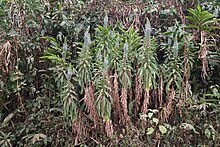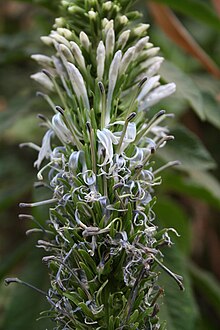Lobelia columnaris
| Lobelia columnaris | ||||||||||||
|---|---|---|---|---|---|---|---|---|---|---|---|---|

Lobelia columnaris in Bioko |
||||||||||||
| Systematics | ||||||||||||
|
||||||||||||
| Scientific name | ||||||||||||
| Lobelia columnaris | ||||||||||||
| Hook. f. |
Lobelia columnaris is a species of the lobelia genus( Lobelia ) within the bellflower family(Campanulaceae). It occurs in a narrow strip in western central Africa .
description

Vegetative characteristics
Lobelia columnaris is an upright, clump-forming, herbaceous plant and reaches a height of 1 to 2 meters during flowering. The hollow stem has a diameter of up to 2 centimeters at the base. It is cylindrical and lignified in cross-section in the lower section and becomes angular and unlignified in cross-section towards the top, the hair becomes stronger towards the inflorescence. The milky juice is white.
The alternate leaves are sessile. With a length of 12 to 19 centimeters and a width of 2 to 6 centimeters, the simple leaf blades are narrowly elliptical-lanceolate, obscure-lanceolate or lanceolate, narrowly winged at the base and pointed to acuminate at the top. The leaf edge is curled, approximately ganzrandig to cut serrated or irregular. The occasionally whitish side ribs are in 19 pairs and are deepened from the top, protruding from the bottom. The hairless to downy-haired upper side of the leaf is dark green, often tinged with purple. The slightly downy to tomentose hairy underside of the leaf is paler.
Generative characteristics
The unbranched, dense inflorescence is 20 to 65 centimeters long and 6 centimeters wide at the time of anthesis . The occasionally whitish nervierten supporting sheets are 15 to 25 millimeters long and 3 to 5 mm wide. There are usually two tiny bracts . The 10 to 15 millimeter long, in cross-section cylindrical pedicels are downy hairy.
The hermaphrodite flowers are zygomorphic with a double flower envelope . The 10 to 15 millimeters long and 1 to 2 millimeters wide sepals are narrow, elongated to almost linear , almost hairless to tomentose and blunt to truncated at the extreme end. The pale purple to bluish crown is 25 to 35 millimeters long and 3 to 4 millimeters wide at the base. It is irregular, but heaped up to about half of the corolla tube, five-lobed, the corolla lobes are 1 to 2 millimeters wide, almost linear and spread. The fluffy, hairy lateral corolla lobes are only slightly different from the others.
The stamens are hairless and 15 to 28 millimeters long. The anthers are 6 to 7 millimeters long and finely haired. The hemispherical, felty hairy ovary is 3 millimeters long and at the outer end 3 to 5 millimeters wide.
The capsule fruit is 6 to 9 millimeters long and 4 to 6 millimeters in diameter, hemispherical, bell-shaped and finely to tomentose. The egg-shaped, flattened, narrow-winged seeds are up to 7 millimeters long.
Distribution and locations
Lobelia columnaris is found in Central Africa, its occurrences extend in the form of a corridor roughly along the Cameroon line from the equatorial Guinean island of Bioko in the south to Tchabal Mbabo in the north of Cameroon , occasionally with finds in Nigeria . It grows there in the highlands at altitudes of 1200 to 2700 meters in moist, open locations on the edges of forests and meadows, but occasionally also secondary, for example on the edges of roads.
Systematics
Lobelia columnaris was first described by Joseph Dalton Hooker in 1862 . She is the only West-Central African representative of a kinship group of giant lobelia, for which the East African mountains are otherwise known. Molecular genetic studies place them in a pantropical group of more than 60 species, which together form the section Rhynchopetalum .
Danger
Lobelia columnaris was classified as "low endangered" by the IUCN in 2000 . In particular, the deposits on the Cameroon Mountain, historically known to be extensive, seemed to be on the decline.
Individual evidence
- ↑ a b c d e f D. J. Mabberley: The Pachycaul Lobelias of Africa and St. Helena. In: Kew Bulletin , Volume 29, Issue 3, 1974, pp. 560-561 JSTOR 4108000
- ↑ data.gbif.org: Lobelia columnaris - GBIF Portal , accessed on January 12, 2014
- ↑ a b Lobelia columnaris in the endangered Red List species the IUCN 2013 Posted by: M. Cheek, S. Cable, 2000. Accessed January 12, 2014.
- ↑ Thomas G. Lammers: Revision of the Infrageneric Classification of Lobelia L. (Campanulaceae: Lobelioideae). In: Annals of the Missouri Botanical Garden , Volume 98, Issue 1, 2011, pp. 37-62.
